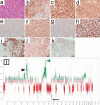Favorable Response to Conventional Chemoradiotherapy in Radiation-induced Glioma Harboring Coamplification of PDGFRA, KIT, and KDR: A Case Report and Literature Review
- PMID: 40343352
- PMCID: PMC12059294
- DOI: 10.2176/jns-nmc.2024-0269
Favorable Response to Conventional Chemoradiotherapy in Radiation-induced Glioma Harboring Coamplification of PDGFRA, KIT, and KDR: A Case Report and Literature Review
Abstract
One of the most serious complications of cranial radiotherapy is the development of radiation-induced glioma, which is estimated to occur in 1%-4% of patients who have received cranial irradiation and has a worse prognosis than sporadic glioblastoma. Although comprehensive genetic analysis has recently uncovered the molecular characteristics of radiation-induced glioma, the full picture remains unclear due to its rarity. A 45-year-old man presented with generalized seizures caused by multiple brain tumors involving the right frontal lobe, thalamus, and brainstem. The patient had a history of whole-brain radiotherapy for recurrent Burkitt's lymphoma at the age of 12. He underwent craniotomy, and the histological diagnosis revealed a high-grade glioma with isocitrate dehydrogenase-wildtype, which was presumed to be a radiation-induced glioma that developed 33 years after whole-brain irradiation. Next-generation sequencing identified a CDKN2A/B deletion, as well as coamplification of several receptor tyrosine kinases-encoding genes, including PDGFRA, KIT, and KDR, all of which are located at 4q12. Amplification of this region is broadly observed across cancers and is associated with poor prognosis in sporadic glioblastoma. Nevertheless, the patient received chemoradiotherapy with temozolomide, followed by temozolomide maintenance therapy, resulting in a complete response of all lesions. Although radiation-induced gliomas are generally difficult to treat, our patient unexpectedly responded well to conventional chemoradiotherapy despite the coamplification of multiple receptor tyrosine kinases-encoding genes, which is typically suggestive of an aggressive phenotype. Our case indicates that some radiation-induced gliomas may have distinct molecular characteristics influencing the therapeutic response, which differ from those of sporadic glioblastomas.
Keywords: 4q12 amplification; next-generation sequencing; radiation-induced glioma; radiotherapy.
© 2025 The Japan Neurosurgical Society.
Conflict of interest statement
All authors have no conflict of interest.
Figures


Similar articles
-
PDGFRA, KIT, and KDR Gene Amplification in Glioblastoma: Heterogeneity and Clinical Significance.Neuromolecular Med. 2023 Sep;25(3):441-450. doi: 10.1007/s12017-023-08749-y. Epub 2023 Aug 23. Neuromolecular Med. 2023. PMID: 37610648 Free PMC article.
-
A tailored next-generation sequencing panel identified distinct subtypes of wildtype IDH and TERT promoter glioblastomas.Cancer Sci. 2020 Oct;111(10):3902-3911. doi: 10.1111/cas.14597. Epub 2020 Sep 6. Cancer Sci. 2020. PMID: 32748499 Free PMC article.
-
The Pan-Cancer Landscape of Coamplification of the Tyrosine Kinases KIT, KDR, and PDGFRA.Oncologist. 2020 Jan;25(1):e39-e47. doi: 10.1634/theoncologist.2018-0528. Epub 2019 Oct 11. Oncologist. 2020. PMID: 31604903 Free PMC article.
-
Characteristics and therapeutic strategies of radiation-induced glioma: case series and comprehensive literature review.J Neurooncol. 2022 Sep;159(3):531-538. doi: 10.1007/s11060-022-04090-9. Epub 2022 Aug 3. J Neurooncol. 2022. PMID: 35922583 Review.
-
Radiation-Associated Glioblastoma after Prophylactic Cranial Irradiation in a Patient of ALL: Review of Literature and Report of a Rare Case.Pediatr Neurosurg. 2020;55(6):409-417. doi: 10.1159/000511996. Epub 2020 Dec 3. Pediatr Neurosurg. 2020. PMID: 33271550 Review.
References
Publication types
LinkOut - more resources
Full Text Sources
Miscellaneous

